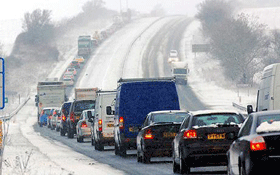
The reminder to slow down during winter weather shouldn't be necessary, but it is. Even in this time of 4-wheel drive SUVs and all-wheel drive crossovers, cell phones and GPS systems, it's important to remember the basics of winter weather driving.
Before You Head Out
Inspect Your Tires
Make sure you have plenty of tread and your tires are inflated to the right pressure. Running tires at too high or too low of pressure is dangerous any time of the year, but can be especially harmful during winter weather conditions when traction is most needed.
Check Your Battery
Check the clamps and clips that are attached to your battery and make sure there's a clean connection. Test to make sure your battery holds a full charge. The cold temperatures of winter cause the chemical reactions of batteries to happen more slowly. Also, because your oil is cold and thicker, your car needs more energy to start.
Test Your Antifreeze
Pick up an antifreeze tester and make sure your coolant can handle your region's low temperatures. If your antifreeze isn't strong enough, or diluted with too much water, it can freeze in sub-zero temperatures. Since liquids expand when turned to ice, it can cause major damage if it freezes in your engine.
Replace Windshield Wipers
If your windshield wipers are worn, replace them with heavy-duty winter wipers.
Change Windshield Washer Fluid
If you don't have low-temperature windshield washer fluid in your reservoir, it may freeze when you need it most.
Completely Clear Your Car of Snow
Before you put your car in drive make sure it is completely cleared of snow and ice. Have a broom, snow brush and ice scraper available to achieve a cleared car. If you leave a tower of snow on top of your vehicle, you're endangering anyone behind you.
When Driving
Allow Ample Breaking Time
Four-wheel and all-wheel-drive vehicles weigh more than 2-wheel drive vehicles and therefore take longer to stop. Becoming overconfident because of your snow tires, four-wheel drive or oversized truck can be dangerous. Be aware of the road conditions and have realistic expectations of how your vehicle will behave.
Light Up
Turn your lights on in winter weather driving conditions – rain, sleet, snow, and fog. Having your lights on will make you more easily seen by other drivers.
Semis
Be careful around semi trucks or any oversized truck. Larger vehicles take longer to stop, and the large tires may create more spray than your wipers can handle and this can lead to interstate accidents. Remember when following a semi – if you can't see its side mirror, the driver can't see you.
Final Tips
- Bridges and overpasses will ice up before other roads. Use extra caution.
- If there is snow or ice on the roads, avoid driving if possible. Consider public transportation instead.
- Keep your fuel tank full in case you're stranded. You'll need to run the car for warmth. And the extra weight in the fuel tank can improve your car's handling in snow and ice.
- If you have rear-wheel drive, consider adding some extra weight to the front of your trunk or as close to the rear axle as you can. The extra weight could help improve traction.
Was there something that should have been included in this list? Voice your opinion in the comments section.

 To request an appraisal, please complete the sections below:
To request an appraisal, please complete the sections below: